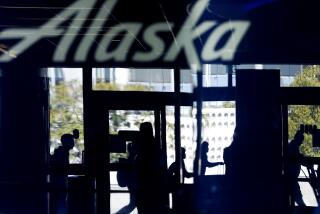Airplane bird strikes are common but rarely dire
- Share via
Commercial and private pilots report thousands of incidents a year where birds hit their aircraft, but the vast majority of the potentially dangerous encounters do not result in substantial damage or serious crashes.
Birds are being investigated as the possible cause of Thursday’s US Airways incident. Authorities said the pilot of the Airbus A320 reported a “double bird strike” during takeoff, forcing the crew to make an emergency landing in the Hudson River as both engines lost power.
“Bird strikes are not uncommon, and they cost the airline industry millions of dollars a year,” said Jon Russell, a commercial pilot and Western region safety coordinator for the Air Line Pilots Assn. “But a dual engine flameout is very unusual. I’ve never heard of that before.”
Between 1990 and 2007, civilian pilots reported 79,972 bird strikes to the Federal Aviation Administration. About 85% came from commercial airlines and the rest involved business, private or government aircraft. According to the FAA, 43 planes and helicopters were destroyed or damaged, mostly light aircraft. Eight strikes resulted in a total of 11 deaths.
In the last three decades, the National Transportation Safety Board looked into 130 such incidents. Many strikes were survived by hundreds of shellshocked passengers, some of whom recounted engine fires and hearing a loud bang like a firecracker as their jetliner ascended. The collisions often occur at low altitude during takeoffs, climbs and landings.
On Nov. 29, 2007, a western grebe struck the No. 2 engine of a Boeing 757-200 as it climbed to 1,000 feet after takeoff from Los Angeles International Airport. The plane returned to LAX and made an emergency landing. FAA officials said the bird damaged 13 fan blades, which cost more than $1 million to repair.
In November 1997, a Northwest Airlines Airbus A320 made an emergency landing at John Wayne Airport after a bird flew into an engine. All 103 passengers and crew aboard Flight 208 were uninjured, but they described an unsettling 30-minute ride as the pilot circled over what then was the El Toro Marine Corps Air Station to burn excess fuel before landing amid a phalanx of firefighters, airport security and other personnel.
In one of the worst military accidents involving a bird strike, all 24 U.S. Air Force personnel were killed on Sept. 22, 1995, when their Boeing E-3B surveillance plane encountered a flock of Canada geese shortly after takeoff from Elmendorf Air Force Base near Anchorage. Geese flew into two of the plane’s four engines, causing them to lose power.
The area where Thursday’s incident occurred is known for its flocks of Canada geese. According to a recent study by the U.S. Department of Agriculture, there have been at least eight major incidents in which flocks have struck planes departing or landing at New York area-airports since 1995.
The data suggest that the geese strikes are more prevalent in the New York area than anywhere else. In that period, there were three at LaGuardia, including one flight that had to be diverted to Newark Liberty International Airport, and five at John F. Kennedy International Airport. One at JFK in 1995 involved a Concorde supersonic jet, which struck a flock of geese as it was landing. Two of the four engines were destroyed, but no one on the plane was injured, according to the report.
“You can hear them hit, and you check your engine parameters,” said Russell, the Air Line Pilots Assn. official, who flies out of LAX. “It’s a scary thing. Birds have gone through fuselages and windshields.”
The number of bird strikes reported by civilian pilots to the FAA has dramatically increased, from 1,738 in 1990 to 7,439 in 2007. Globally, bird strikes have killed more than 220 people and destroyed more than 200 aircraft since 1988. According to the FAA, the increase coincides with a significant rise in commercial air travel in the United States as well as a resurgence of bird populations in urban environments.
To guard against debris being sucked into aircraft engines, LAX and many other airports have dozens of staff patrolling runways and taxiways 24 hours a day.
The airport also works with wildlife biologists to relocate fowl and ensure that vegetation on its 3,500 acres doesn’t attract birds and other wildlife that could get in an aircraft’s way.
Raymond Jack, the operations manager at LAX, said the primary threat in Los Angeles comes from crows, pigeons and kestrels.
But he said the region does not have as many large game birds or migratory paths as airports in the Midwest or Northeast.
Multi-engine jets are designed to continue flying if they lose power in one of their engines, especially during takeoffs.
“Jet engines are designed so that a single bird in the intake cannot dismantle the engine,” said Cyrus K. Madnia, a professor of mechanical and aerospace engineering at the University at Buffalo’s School of Engineering and Applied Sciences.
It can be a different story, however, if many birds are the culprit, Madnia said.
--
--
Times staff writers Peter Pae and Jennifer Oldham contributed to this report.
More to Read
Sign up for Essential California
The most important California stories and recommendations in your inbox every morning.
You may occasionally receive promotional content from the Los Angeles Times.











